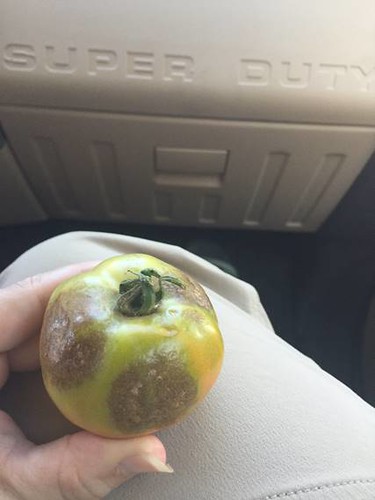Late blight hitting Arkansas tomatoes early
By Fred Miller
University of Arkansas System Division of Agriculture
June 21, 2016
Fast Facts:
- Late blight has been found early in Arkansas tomatoes.
- The disease affects leaves and fruit and leads to rapid death of the plant.
- Infected plants should be destroyed to prevent spreading.
FAYETTEVILLE, Ark. — Heavy spring rains have delivered a destructive fungal disease to Arkansas tomato growers.
Jackie Lee, horticulture integrated pest management specialist for the Arkansas Cooperative Extension Service, said late blight has been found this year at a dramatically higher rate than usual.
Typically, Lee said, the University of Arkansas System Division of Agriculture’s plant diagnostic lab sees about three samples a year with the disease. But this year, the lab has already diagnosed more than 20 infected plants.
The affected areas so far include 14 counties around central Arkansas, Lee said. These counties generally have seen the heaviest rainfall this year.
“This disease can affect tomato, potato, pepper and eggplant,” Lee said. “I have mainly seen it in tomato.”
The disease affects the foliage and the fruit and causes rapid death of the plant, Lee said. The first signs of the disease are necrotic brownish gray tissue on the leaves.
“It is often referred to as a bottom up disease,” Lee said. “It will knock out all of the bottom leaves as it moves up the plant. It is very difficult to control once symptoms begin to show.”
Lee said the best way to manage late blight is to start a fungicide spray program at planting. She recommends fungicide applications to plants that are not affected to help prevent the spread of the disease or, if symptoms are just beginning, an application may be able to stop the spread.
Recommended fungicides can be found on the Cooperative Extension Service’s “Arkansas Plant Disease Control Product Guides — MP154.” The list of PDF guides includes recommendations for tomato diseases in commercial production and home gardens.
The guides can be downloaded from this link: http://www.uaex.uada.edu/publications/mp-154.aspx
If the disease has progressed, Lee said, the plants should be destroyed by burning them or throwing them out in plastic trash bags so that spores cannot escape.
Lee warned that if infected plants are not properly destroyed spores that transmit the disease can quickly move to uninfected plants on the farm or even from farm to farm. Discarding infected plants will help lower the accumulation of spores and help prevent spread to plants that are healthy.
Proper disposal of infected plants will also decrease the disease pressure in the following year, though not eliminate it, Lee said. The spores remain active in the soil and susceptible crops should not be planted for three years in soil where infected plants have been.
Lee said there are some resistant varieties, including Iron Lady, Defiant PHR, Mountain Merit, Plum Regal and others.
The counties affected so far include Clark, Lee, Hot Spring, Independence, Boone, Conway, Dallas, Garland, Bradley, Clark, Pulaski, Grant, White and Dallas counties.
Growers who suspect late blight in their tomatoes should contact their county extension offices about sending samples to the plant diagnostic lab.
Media Contact: Mary Hightower
Dir. of Communication Services
U of A Division of Agriculture
Cooperative Extension Service
(501) 671-2126
mhightower@uada.edu
Related Links
